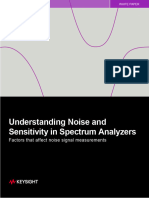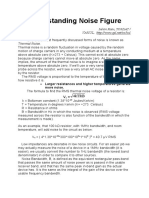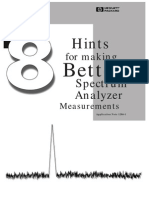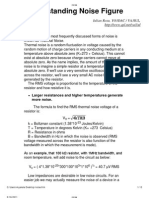Preampswithspecanalyzers
Preampswithspecanalyzers
Uploaded by
Data KiswaraCopyright:
Available Formats
Preampswithspecanalyzers
Preampswithspecanalyzers
Uploaded by
Data KiswaraOriginal Title
Copyright
Available Formats
Share this document
Did you find this document useful?
Is this content inappropriate?
Copyright:
Available Formats
Preampswithspecanalyzers
Preampswithspecanalyzers
Uploaded by
Data KiswaraCopyright:
Available Formats
Using Preamps With Spectrum Analyzers
Dr. Bruce Gabrielson
Security Engineering Services
Preamplifiers improve spectrum analyzer sensitivity by decreasing the noise figure of
the pre- amplifier/analyzer combination. As preamplifier gain increases and noise
figure decreases, analyzer sensitivity increases. To achieve maximum sensitivity
without significantly degrading dynamic range, gain must be optimized. To
determine the optimum gain, the overall system noise figure must first be evaluated,
as follows:
Ftot = the total noise figure of the spectrum analyzer and preamplifier combination,
F1 = the noise figure of the pre- amplifier
F2 = the noise figure of the spectrum analyzer, and
G1 = the power gain of the preamplifier.
The first criteria for the preamplifier design is clearly a preamplifier noise figure
much lower than that of the spectrum analyzer. Second, the equation shows that the
total noise figure decreases when G1 increases and approaches F1 that is, when G1
becomes very large compared to F2. Therefore, because the spectrum analyzer's noise
level is proportional to F2.the lowest total noise level- or best sensitivity-is obtained
with the highest preamplifier gain.
However, inherent problems exist. The
use of any preamplifier results in the
reduction of the spectrum analyzer's
dynamic range. A preamplifier with
gain of G1 reduces the input 1-dB
compression point level by G1.
However, the decrease in noise level is
not proportional to G1, as shown in the
equation. Therefore, there must be an
optimum gain (G1 at which the
increase in sensitivity is significant
without an objectionable loss of
dynamic range.
A basic setup of the spectrum analyzer
with an internal noise figure of F21 and
a preamplifier with noise figure of F1
and gain of G1 is shown in Figure 1. Figure 1 - Noise Level Improvement Function
The figure shows the noise-level
improvement function R1G1 as a function of G1 expressed in decibels, for a
preamplifier with a noise figure F1 equal to 10 dB and a spectrum analyzer with a
noise figure F2 equal to 30 dB. The preamplifier gain is variable. The ratio of the
input noise of the spectrum analyzer without a preamplifier to the input noise with a
preamplifier (shown in the plot) indicates the result of increasing preamplifier gain.
As the gain G1 in- creases, sensitivity increases significantly until the gain reaches 20
dB. The curve indicates that gains higher than 20 dB, the sensitivity does not increase
significantly.
Another function of interest is the ratio R1(G1) of the dynamic range of the spectrum
analyzer alone to the dynamic range of the spectrum analyzer with a preamplifier.
Figure 2 shows a plot of the R1(G1) in decibels, versus the preamplifier gain, G1. The
curve indicates that for gains less than 20 dB, degradation is very small. Dynamic
range degradation increases rapidly (and the dynamic range decreases) as the
increasing preamplifier gain,
Expression of Merit
The product of the two functions
R1(G1) and R2(G2) is defined as
R(G1), the preamplifier's
expression of merit. In essence,
R(G1) is the ratio of the increase
in sensitivity and the decrease in
dynamic range, as a function of
G1.. When evaluating R1(G1) and
R2(G2), it is evident that the merit
function R(G1) increases at low
gain, indicating that the
sensitivity increases without Figure 2 - Dynamic Range Degradation with Gain
sacrificing dynamic range.
However, as preamplifier gain increases, the merit function decreases. This decrease
indicates that sensitivity improves only slightly, but there is a severe reduction in
dynamic range.
Summary
The overall noise figure of the preamplifier/analyzer system, using the optimum
preamplifier gain, is 3 dB higher than the noise figure of the preamplifier alone. In
summary, when a preamplifier is used with a spectrum analyzer, its optimum gain
will decrease dynamic range by only 3 dB, but will increase the sensitivity by the
difference in noise figures of the spectrum analyzer and the preamplifier, minus 3 dB.
You might also like
- Noise Power Ratio Measurement TutorialDocument5 pagesNoise Power Ratio Measurement TutorialRoberto Macias50% (2)
- Linear and Nonlinear AmplificationDocument37 pagesLinear and Nonlinear AmplificationAhiawortor KplorlaNo ratings yet
- CIE 318 ProjectDocument5 pagesCIE 318 ProjectAlin mathuoNo ratings yet
- Agilent LNA Design NoteDocument62 pagesAgilent LNA Design NotejrmciNo ratings yet
- Understanding Noise and Sensitivity in Spectrum AnalyzersDocument10 pagesUnderstanding Noise and Sensitivity in Spectrum AnalyzersVarun Singh RathoreNo ratings yet
- AppNote - Noise - Using Markers To Estimate Noise Figure (11410-00653A)Document4 pagesAppNote - Noise - Using Markers To Estimate Noise Figure (11410-00653A)ScribdFgNo ratings yet
- 1-dB CompressionDocument5 pages1-dB Compressionminh_thanhNo ratings yet
- Amplifier Terms DefinedDocument14 pagesAmplifier Terms DefinedMatthew CarterNo ratings yet
- Project Report: ON Stereo Brick AmplifierDocument43 pagesProject Report: ON Stereo Brick AmplifierShoaib KhanNo ratings yet
- RF Amplifier Module Test Setup: Operating Frequency Range and GainDocument10 pagesRF Amplifier Module Test Setup: Operating Frequency Range and GainlodeNo ratings yet
- Communication Theory Question Bank Unit 4Document2 pagesCommunication Theory Question Bank Unit 4muthubeNo ratings yet
- L Band Low Noise AmplifierDocument4 pagesL Band Low Noise AmplifierDestia RahmawatiNo ratings yet
- Unit 5 Multistage Amplifiers PDFDocument55 pagesUnit 5 Multistage Amplifiers PDFSowndaryaNo ratings yet
- Spectrum Analysis Basics-trang-5Document36 pagesSpectrum Analysis Basics-trang-5Khuất Hùng CườngNo ratings yet
- Lna ReportDocument28 pagesLna ReportPranjal JalanNo ratings yet
- Digital Electronics NotesDocument108 pagesDigital Electronics Notesksreddy2002No ratings yet
- Feedback AmplifiersDocument21 pagesFeedback AmplifiersNon Artists100% (1)
- (AMW9907) Computing The LO Phase Noise Requirements in A GSM ReceiverDocument3 pages(AMW9907) Computing The LO Phase Noise Requirements in A GSM ReceiverpacificfisheryNo ratings yet
- Understanding Noise Figure: PDF VersionDocument12 pagesUnderstanding Noise Figure: PDF VersionFahim Ahmed AbbasiNo ratings yet
- Spectrun Analysis 8554-8447Document24 pagesSpectrun Analysis 8554-8447symasiNo ratings yet
- IMD UbaDocument12 pagesIMD UbaWalter RossiNo ratings yet
- Characteristics of AmplifierDocument10 pagesCharacteristics of Amplifierinformation and telecommunication engineeringNo ratings yet
- Figures of Merit: Theoretical FrameworkDocument4 pagesFigures of Merit: Theoretical Frameworkr4ul90No ratings yet
- An 00008Document5 pagesAn 00008ClenaNo ratings yet
- VU Meter Myths. Best Practices in Getting The Clean SoundDocument6 pagesVU Meter Myths. Best Practices in Getting The Clean SoundFrancesca OrtolaniNo ratings yet
- Spectrum Analysis Basics-trang-3Document28 pagesSpectrum Analysis Basics-trang-3Khuất Hùng CườngNo ratings yet
- Improve Two-Tone, Third Order TestingDocument6 pagesImprove Two-Tone, Third Order TestingprotonNo ratings yet
- Lna Report 111111Document29 pagesLna Report 111111Pranjal JalanNo ratings yet
- Unity-Gain ENDocument5 pagesUnity-Gain ENalexbilchukNo ratings yet
- DFT 4Document1 pageDFT 4ankit trivediNo ratings yet
- Filter Analysis: Rode NT5 Frequency PlotDocument2 pagesFilter Analysis: Rode NT5 Frequency PlotJuan PavezNo ratings yet
- An1286 1 Spectrumanalyzers 8hitsDocument12 pagesAn1286 1 Spectrumanalyzers 8hitsaryan21081992No ratings yet
- Gain EstructureDocument15 pagesGain EstructureAbraham Dip PortosNo ratings yet
- LNAdesignDocument30 pagesLNAdesignB BhattNo ratings yet
- Spectrum Dynamic Range5968-4545EDocument16 pagesSpectrum Dynamic Range5968-4545EheliperNo ratings yet
- Receiver Noise Figure MeasurementDocument13 pagesReceiver Noise Figure Measurementعلی بنائیNo ratings yet
- TheGigRig WetBox ManualDocument3 pagesTheGigRig WetBox ManualDiego Marcelo Terrazas VNo ratings yet
- Noise in Analog Communication SystemsDocument32 pagesNoise in Analog Communication SystemsSanjana PulapaNo ratings yet
- 13 - The Decibel and Its UsageDocument10 pages13 - The Decibel and Its Usagesgw67No ratings yet
- Daniel Proj 1999 Microwave LnaDocument8 pagesDaniel Proj 1999 Microwave LnaDhaivat BhattNo ratings yet
- Understanding Noise Figure: PDF VersionDocument13 pagesUnderstanding Noise Figure: PDF VersionVamshi Krishna YakkalaNo ratings yet
- Calculation of System Noise Temperature and Noise PowerDocument13 pagesCalculation of System Noise Temperature and Noise PowerSaptarshi GhoshNo ratings yet
- Design and Development of Low Noise Amplifier For RF/MW ReceiverDocument4 pagesDesign and Development of Low Noise Amplifier For RF/MW ReceiverKunal KhandelwalNo ratings yet
- Analiz Spectru 2 PDFDocument5 pagesAnaliz Spectru 2 PDFFlorin NicolaNo ratings yet
- Receiver Sensitivity 1Document5 pagesReceiver Sensitivity 1Nahum SetuNo ratings yet
- LNA DocumentationDocument15 pagesLNA Documentationuttam DebnathNo ratings yet
- Noise Figure and SNRDocument9 pagesNoise Figure and SNREzhar Savero RomanNo ratings yet
- KoehlerDocument8 pagesKoehlerjlnhabNo ratings yet
- Positive and Negative FeedbackDocument4 pagesPositive and Negative FeedbackNEETA SINGHNo ratings yet
- Hydrogen Part2 1.0Document29 pagesHydrogen Part2 1.0mic_hviidNo ratings yet
- Logarithmic Units: Case 1 Case 2Document9 pagesLogarithmic Units: Case 1 Case 2Carlos Torrez Baltazar100% (2)
- Difference Between Third Order Intercept and P1dBDocument5 pagesDifference Between Third Order Intercept and P1dBTarun SharmaNo ratings yet
- Maximizing Receiver Dynamic Range For Spectrum MonitoringDocument6 pagesMaximizing Receiver Dynamic Range For Spectrum Monitoringchrist_f2009No ratings yet
- Amplifier: The Definition of AmplifierDocument9 pagesAmplifier: The Definition of AmplifierericoNo ratings yet
- Improve Two-Tone, Third-Order Intermodulation TestingDocument5 pagesImprove Two-Tone, Third-Order Intermodulation TestingSteve AyalaNo ratings yet
- Agilent AN 1316 Optimizing Spectrum Analyzer Amplitude AccuracyDocument16 pagesAgilent AN 1316 Optimizing Spectrum Analyzer Amplitude AccuracybilallkhadimNo ratings yet
- Improve Two-Tone, Third Order TestingDocument4 pagesImprove Two-Tone, Third Order TestingVishnuNo ratings yet
- Gamma Correction: Enhancing Visual Clarity in Computer Vision: The Gamma Correction TechniqueFrom EverandGamma Correction: Enhancing Visual Clarity in Computer Vision: The Gamma Correction TechniqueNo ratings yet
- Noise Reduction: Enhancing Clarity, Advanced Techniques for Noise Reduction in Computer VisionFrom EverandNoise Reduction: Enhancing Clarity, Advanced Techniques for Noise Reduction in Computer VisionNo ratings yet
- System Description: Engine Immobiliser - Engine Immobiliser SystemDocument3 pagesSystem Description: Engine Immobiliser - Engine Immobiliser SystemdennoNo ratings yet
- PHYSICS PH112 First DayDocument2 pagesPHYSICS PH112 First DayKIPNGENO EMMANUELNo ratings yet
- Sn7486 XOR GateDocument20 pagesSn7486 XOR Gatepratik gautamNo ratings yet
- Micro InverterDocument4 pagesMicro InverterRadhika PriyadarshiniNo ratings yet
- Tup 047Document3 pagesTup 047PabloAlvNo ratings yet
- Item Code: # SKU Description UnitDocument12 pagesItem Code: # SKU Description Unitabi habudinNo ratings yet
- Fibre Optic Training Completion Report by Noah Olela Abong'o & Fredrick B. MwashigadiDocument21 pagesFibre Optic Training Completion Report by Noah Olela Abong'o & Fredrick B. MwashigadiNABONGO1969100% (3)
- Vertica - Disaster RecoveryDocument3 pagesVertica - Disaster Recoverydaniel4959No ratings yet
- Console Advance Brochure EnglishDocument5 pagesConsole Advance Brochure Englishlabel engineering companyNo ratings yet
- Classification of Pyranometers: PyranometerDocument3 pagesClassification of Pyranometers: PyranometerRiazul IslamNo ratings yet
- Supply Chain Security Risk and Mitigation TechniquesDocument11 pagesSupply Chain Security Risk and Mitigation TechniquesalnasserNo ratings yet
- SAP HR AND HRM Interview Questions and Answers: Learning IT Courses Has Never Been This EasyDocument28 pagesSAP HR AND HRM Interview Questions and Answers: Learning IT Courses Has Never Been This EasyAhmed AshrafNo ratings yet
- GC Compressor Brochure 10-02-20Document6 pagesGC Compressor Brochure 10-02-20arnoldbusaNo ratings yet
- LECTURE 06 EENG405 Mobile Telecommunications Lecture 7& 8 - Introduction To Wireless Access TechnogiesDocument268 pagesLECTURE 06 EENG405 Mobile Telecommunications Lecture 7& 8 - Introduction To Wireless Access TechnogiesTakudzwa MNo ratings yet
- FEM For Rectangular TankDocument6 pagesFEM For Rectangular TankMohamad ArrajNo ratings yet
- Mobile Computing Lab ManualDocument64 pagesMobile Computing Lab Manualvishnu91_k100% (2)
- Yealink CP960 Datasheet PDFDocument3 pagesYealink CP960 Datasheet PDFddhNo ratings yet
- Reviewer in OMGTDocument11 pagesReviewer in OMGTana delacruzNo ratings yet
- Immigration & Visas ConsultantDocument3 pagesImmigration & Visas ConsultantGoForVisaNo ratings yet
- Questionaire: Automatic and Manual Modes of Transmission: A Comparative Study 2019Document4 pagesQuestionaire: Automatic and Manual Modes of Transmission: A Comparative Study 2019Ram KrishnanNo ratings yet
- FAQ-Ibiz MuamalatDocument9 pagesFAQ-Ibiz MuamalatJob Zine'dineNo ratings yet
- Group 2 Expt 8 TheveninsDocument13 pagesGroup 2 Expt 8 TheveninsLolo Ko kalboNo ratings yet
- 13 e Customer ServiceDocument33 pages13 e Customer ServiceandyekabachtiarNo ratings yet
- Accepted Manuscript: Cognitive Systems ResearchDocument27 pagesAccepted Manuscript: Cognitive Systems ResearchDhanalekshmi YedurkarNo ratings yet
- Assalamualaikum and A Very Good Morning To Our Beloved LecturerDocument3 pagesAssalamualaikum and A Very Good Morning To Our Beloved LecturerNick Ganu LCNo ratings yet
- Network System Administration: Assosa University College of Computing & InformaticsDocument88 pagesNetwork System Administration: Assosa University College of Computing & InformaticsKemal HussenNo ratings yet
- Measuring Relays and Protection Equipment: BSI Standards PublicationDocument36 pagesMeasuring Relays and Protection Equipment: BSI Standards Publicationyand_carlos86% (7)
- IoT-_Internet-of-things_-Fruits-and-Vegetables-Quality-Monitoring-Systems-VIKAS-KUMAR-17Document3 pagesIoT-_Internet-of-things_-Fruits-and-Vegetables-Quality-Monitoring-Systems-VIKAS-KUMAR-17Jay PatilNo ratings yet
- Survey QuestionnaireDocument9 pagesSurvey QuestionnaireViele Antonette NaranjoNo ratings yet

























































































